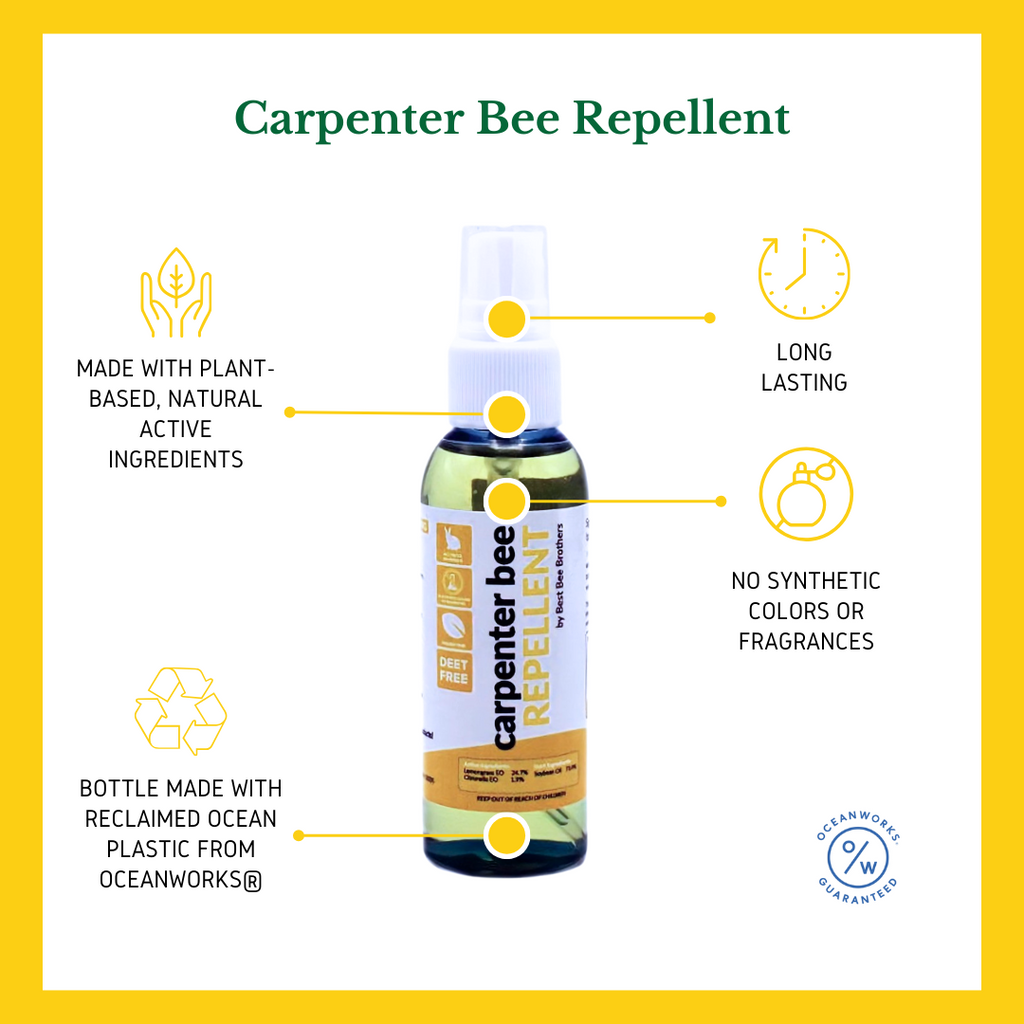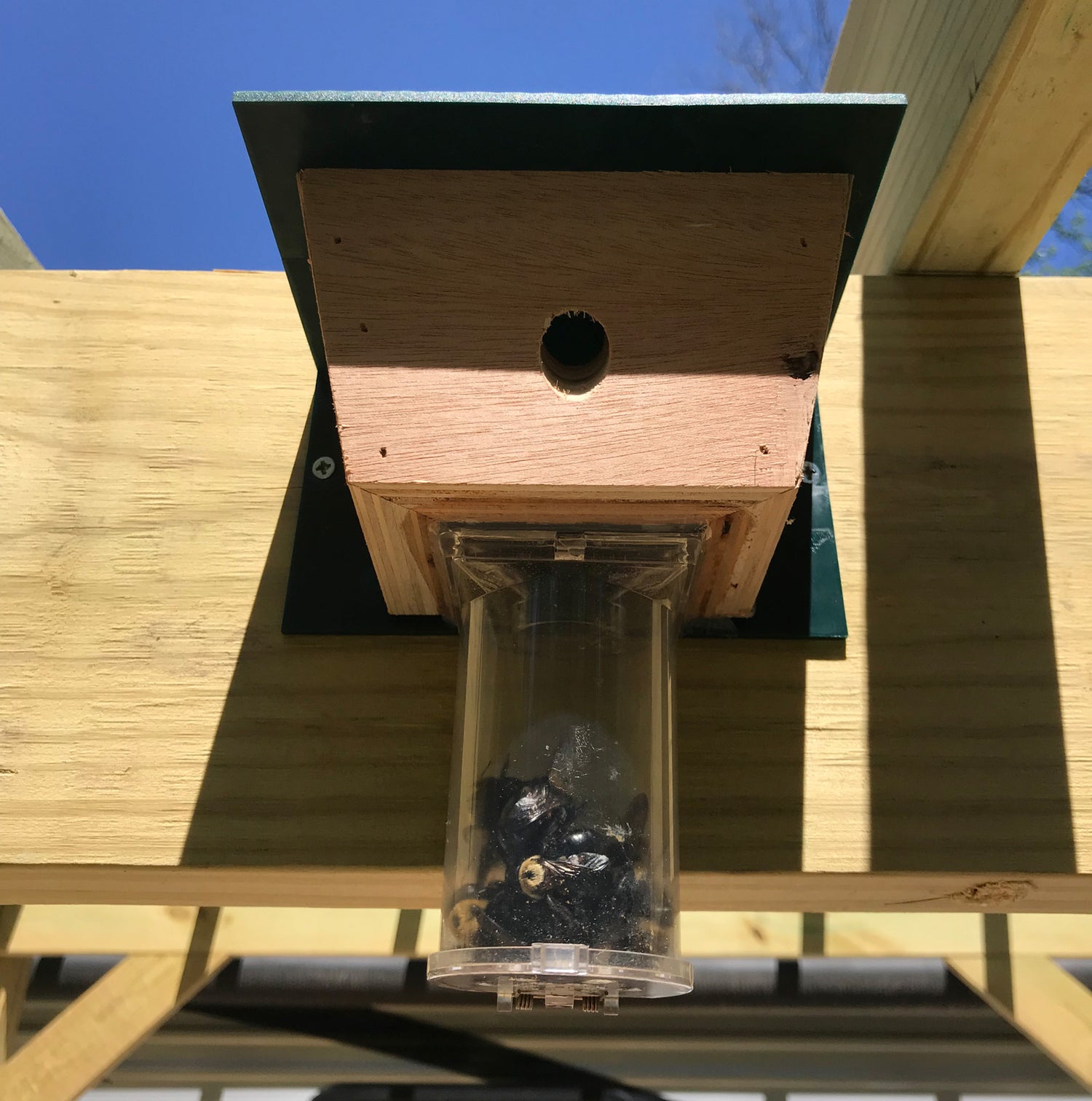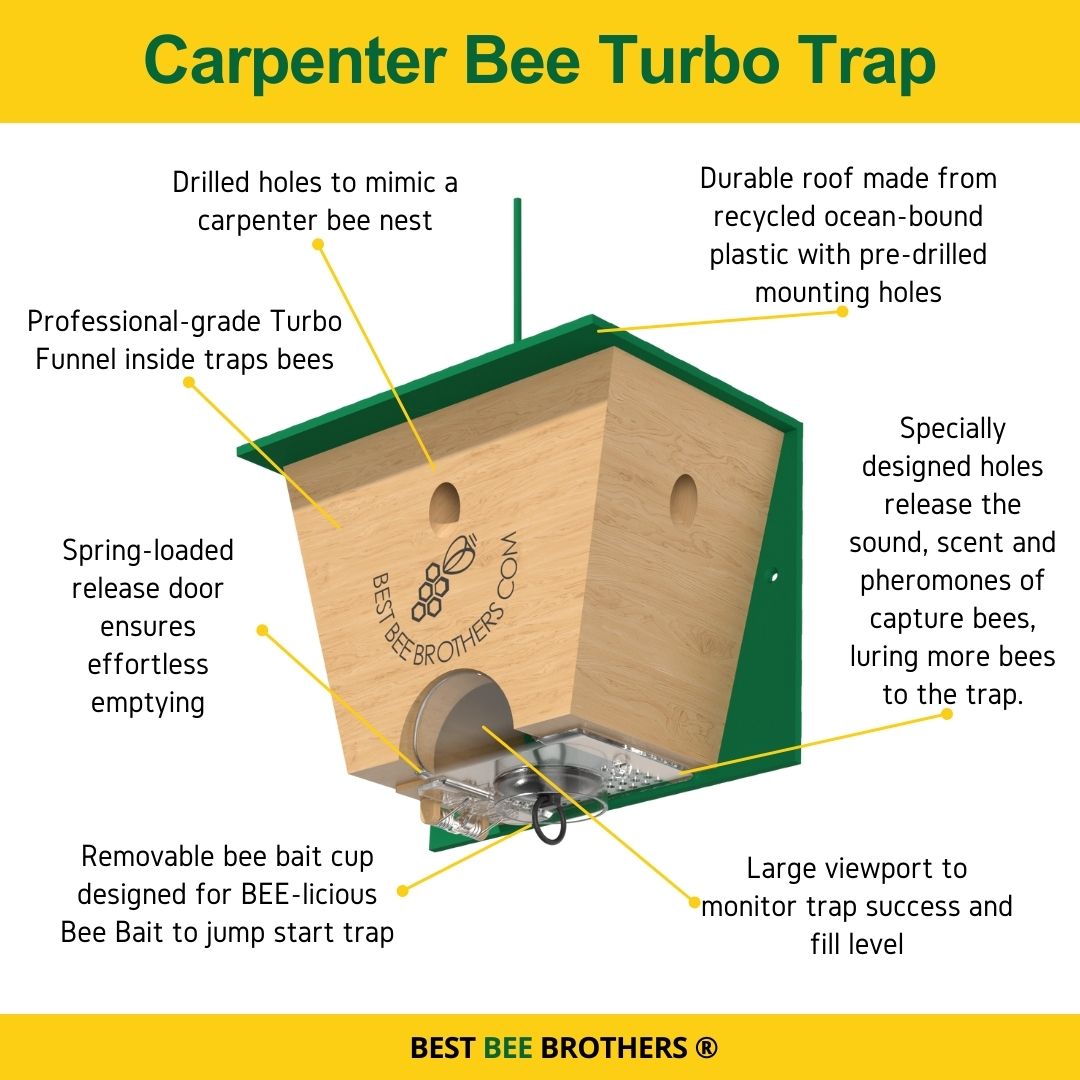Even though carpenter bees are most active during spring and summer, they can cause lasting (and expensive!) damage to homes and surrounding structures, such as gazebos and pergolas.
Because these insects prefer untreated wood to build their nests, your residence can become a target when they’ve emerged from hibernation. If you notice half-inch-diameter holes bored into your wood structures, wood shavings below the holes, or a large fuzzy bee with a blue-black abdomen buzzing around them, you likely have a carpenter bee problem!
Fortunately, Best Bee Brothers® specializes in solutions formulated without harsh chemicals and in evidence-based recommendations to stop these creatures before they become a big problem for your family. Our favorite carpenter bee repellents and tools are safe and easy to use – no toxic insecticides are required.
Fall Prep toDeter Carpenter Bees
- Seal up any wooden divots or pre-existing holes in your wood. Every spring when female carpenter bees start their search for new homes, they seek out imperfections in wood as ideal places to begin nests. In the fall, use wood putty or our Hand Dipped Wooden Corks, specially sized for carpenter bee holes, to cover up nest holes and crevices so that your home is less appealing to these pests in the spring.
- Repair damage from old carpenter bee nests. Fall is the best time to treat carpenter bee damage. Carpenter bee mating season has ended, and there are fewer bees to contend with. To make prep easy, we recommend our Total Bee-Fense Kit. It includes wooden corks to cover up preexisting holes, as well as our citrus spray and the Bee-Destroyer Stake to make removing any debris in nest tunnels easy. The kit can also be used in the spring, and the citrus spray will help protect your outdoor wooden areas that aren’t ideal for a carpenter bee trap (e.g., wooden patio furniture).

How to Get Rid of Wood Bees in the Spring
In an ideal world, you could stop carpenter bees before they wreak havoc on your wooden structures. If you’d like to know how to prevent these pests, check out our spring prep blog post. Hanging your carpenter bee traps before you have a problem is your best strategy, but no need to worry if you already have an infestation. Let’s discuss how to get rid of these insects without toxic chemicals.
If you notice the telltale signs (see above) of a carpenter bee problem, it’s important to take action immediately. Hang your carpenter bee traps ASAP in spring! Best Bee Brothers traps will attract carpenter bees in the area, as they’re designed with these bees’ unique behavior in mind. Rest assured, pollinators like honeybees and bumblebees will stay away and continue their visits to your flowers and vegetables.
To ensure your carpenter bee traps effectively neutralize these insects, follow our tried-and-true techniques:
- Each trap has a 15-foot working radius, so hang accordingly! We recommend placing them in your roof’s eaves and overhangs, where our field testing has found them to be most effective.
- Jump-start your removal process with a dime-sized amount of BEE-Licious Bee Bait, our carpenter bee attractant, in the bait cup or the circle labeled “Bee Bait,” depending on your trap model.
- Take a few minutes to examine your home and surrounding structures for existing carpenter bee nests; plug the holes to direct the bees to the traps.

Remove Carpenter Bees: Best Carpenter Bee Repellents
-
Use citrus spray to protect wood.Citrus scent is highly repulsive to carpenter bees, which is why our Citrus Carpenter Bee Repellent Spray works so well. Depending on the weather, every few days during spring and summer is the best time to spray this handcrafted carpenter bee repellent. Carpenter bees will avoid the citrus-scented wood, keeping patio and porch furniture as well as play sets protected.

- Use almond oil to repel. When applied to wood, almond oil has similar repelling effects to citrus spray. Carpenter bees hate the scent, and it will keep them from nesting on sprayed wood. Some people have also had luck spraying new nest openings with almond oil to get existing carpenter bees to leave. Mix the almond oil with water to spray on wood, or apply the oil directly to carpenter bee nest holes1.
- Vacuum carpenter bees away. If you have a strong enough vacuum with a small attachment, you might be able to vacuum the carpenter bees out of their nest. This works best when the nests are new and not very deep. Vacuuming will not get any larvae, so make sure to seal up the nest properly after removing the adults.
- Play loud music! Some people have found that playing loud music next to active nests causes the carpenter bees to decamp, at least for a short while. This method can work because carpenter bees are sensitive to sound, and the vibrations from the music would be unpleasant to them. This gives you an opportunity to repair a nest before the adults return. Make sure to hang up a carpenter bee trap after sealing the nest to catch the fleeing adult carpenter bees!
-
Hit them with rackets! Because carpenter bees are so large, they make excellent targets for badminton and tennis rackets. We even have electric rackets to help pack a punch! This is certainly effective at getting rid of the carpenter bees that come too close. However, those tend to be male so, unfortunately, killing them won’t stop a nest from growing. Collect any dead bees and place them in your carpenter bee trap to make the trap more effective. Watch our video to see how it works.

- Sprinkle diatomaceous earth in the nests to kill larvae and bees. Does diatomaceous earth (DE) kill carpenter bees? The answer is yes. You can use this natural carpenter bee repellent for bees and also for wasps. As mentioned above, this is because DE will kill any creature with an exoskeleton. If treating a wasp nest, do your research and take extra precautions before treating a nest, as wasps are extremely aggressive.
Carpenter Bee Prevention Recap
Naturally repelling carpenter bees is not difficult when you have the right carpenter bee repellent and tools. Be proactive, and hang your Best Bee Brothers carpenter bee traps up at the beginning of spring. Remember to take immediate action if you see any nests or damage, and be sure to keep your traps up until fall to conquer the small second season.
References:
- Susan C. Jones, “Carpenter Bees,” fact sheet HYG-2074, July 3, 2017, Ohioline, Ohio State University Extension, https://ohioline.osu.edu/factsheet/hyg-2074.
- T. R. Bunch, C. Bond, K. Buhl and D. Stone, “Diatomaceous Earth Fact Sheet,” January 2013, National Pesticide Information Center, Oregon State University Extension, http://npic.orst.edu/factsheets/degen.html.
-
Bunch et al., “Diatomaceous Earth Fact Sheet.”









4 comments
Customer Support
@Whitney – I think this video will help answer your question: https://bestbeebrothers.com/pages/video-when-should-i-empty-my-trap
~Best Bee Brothers
Whitney
This may seem obvious, but what’s the best way to empty our traps when most of the bees are alive? We have been waiting for them to die – and they aren’t! Our traps are so full that new bees are flying right back out.
Customer Support
@Elvis Hill – Simply apply a dime-sized amount of our Bee Bait to the inside of the receptacle before you hang your trap! You can find more information here: https://bestbeebrothers.com/blogs/blog/attracting-bees-to-your-carpenter-bee-trap ~Customer Support
Elvis Hill
When and where do I use the Bee-licious at?
Leave a comment
All comments are moderated before being published.
This site is protected by hCaptcha and the hCaptcha Privacy Policy and Terms of Service apply.